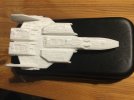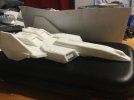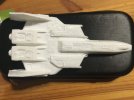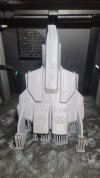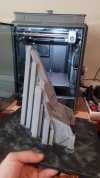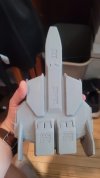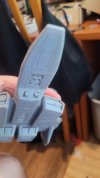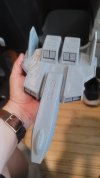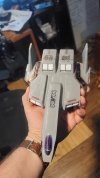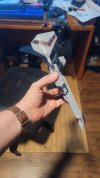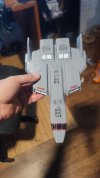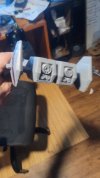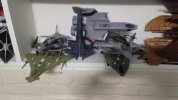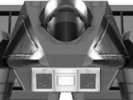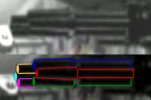You can pretty much print anything you can model, with some structural and mechanical considerations for the printing method.
Liquid resin printers are much better at producing high fidelity prints at smaller sizes, and generally produce better models like this, which come out needing almost no clean-up. Filament spool printers like mine are better for large-scale construction, and produce rougher models, but they can print in sturdier materials. I stick with filament printers for a couple reasons, mainly that I don't care for the fumes and curing process of the liquid resin, and that I can make much bigger, rugged prints in ABS, like costume props or the instrument components I'm making for a flight simulator cockpit I'm building.
This model started off as something for a game, and I gradually added the details. The model itself was very simple, and all the detail was made with textures. It's come a really long way since.. oh, around 2001. 🤣 Fun fact, the original one on the left is about 1,300 polygons, while the printing model clocks in at about 101,000.
View attachment 13416
One thing I did do was add a bunch of manual support structures to help the print succeed. I did it to preserve the edges on the faces against the build plate, and to give taller parts support as they printed, but that may or may not be necessary based on the capabilities of individual printers. It added significantly to the amount of cleanup, but the supports were very thin, so they didn't use much plastic.
View attachment 13417
I'm working on putting things together into a build package now for anyone here to test if they want. The above image shows my mesh division, and it's a little odd, because I built the model in 3DS Max, and it doesn't have features like a typical manufacturing CAD program, which would allow you to adjust features like panel lines after they're made. It also doesn't allow for easy definition of thickness, so I kept the interior walls of the model (in red) separate from the exterior surfaces (blue) to make them easier to edit. If I distribute this in STL format, that distinction will likely be lost, but it won't stop you from printing the model as shown.
I think the only thing I didn't wind up making was landing gear for it, but it wouldn't be hard to add swappable gear, so I could do it if someone really wants. For the front gear I'd just need to recess the gear bay, and make two plugs, one with closed doors, and one that's open with the extended gear. The rear wheels look like they just pop out of the bottom edge of the lower fins. I think there's a door that opens on the inside of the fins to let a small strut extend inward, and that wouldn't be hard to add since the tails are pretty simple. I could just make a rectangular plug that would swap out a center section of the fin for spread doors and a wheel sticking down.
Anyone who wants to give it a shot, either with a resin or FDM printer at any scale, let me know what you'd prefer, and I can export what you need.
I really want to build up a couple more fighters to print, but I feel like I should learn some actual CAD software to use instead of the insane process I used to build this. All of the panel lines were cut by making panel line meshes, and cutting them directly into the model via boolean operations. I would
much rather be able to just let the software automatically engrave the lines into the surface.
